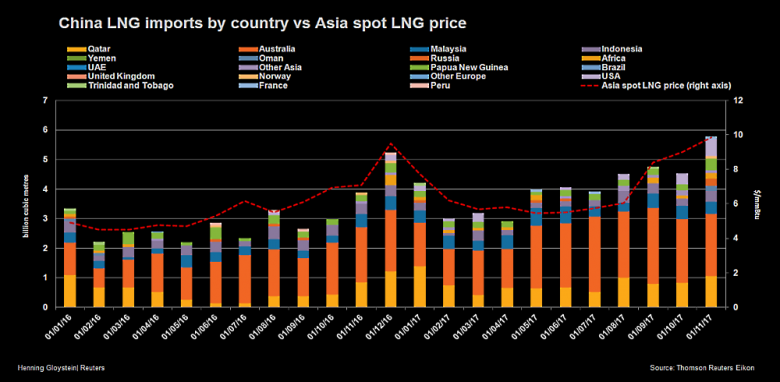
CHINA'S LNG IMPORTS UP BY 46%

EIA - China surpassed South Korea to become the world's second-largest importer of liquefied natural gas (LNG) in 2017, according to data from IHS Markit and official Chinese government statistics. Chinese imports of LNG averaged 5 billion cubic feet per day (Bcf/d) in 2017, exceeded only by Japanese imports of 11 Bcf/d. Imports of LNG by China, driven by government policies designed to reduce air pollution, increased by 1.6 Bcf/d (46%) in 2017, with monthly imports reaching 7.8 Bcf/d in December.
China's imports of natural gas have grown to meet increasing domestic natural gas consumption, which has been primarily driven by environmental policies to transition away from coal-fired electricity generation. The Chinese government has also implemented policies to convert several million residential households in China's northern provinces, which traditionally rely on coal heating in the winter, to use natural gas-fired boilers instead.
Natural gas storage capacity in China is relatively limited, estimated at just 3% of total natural gas consumption. China's seasonal peak demand is met primarily by natural gas imports, either by pipeline from Central Asia or by shipments of LNG. Despite increases in China's domestic production and in pipeline imports in 2017, natural gas shortages in northern China led to record levels of LNG imports during the 2017 winter. Overall, natural gas imports accounted for 40% of China's 2017 natural gas supply, and LNG made up more than half of those imports.
China has 17 LNG import terminals at 14 ports along its coastline, with a combined regasification capacity of 7.4 Bcf/d. Annual utilization rates at LNG import terminals averaged about 50% from 2013 through 2016, but the rate increased to 69% in 2017. Colder-than-normal winter weather increased natural gas demand and led LNG import terminals in the northern and central coastal regions of China to exceed nameplate capacity by 30% and 20%, respectively, in December 2017.
EIA expects natural gas consumption in China to continue to increase—driven by economics and environmental policies—and imports and increasing domestic production will be used to meet growing demand. China's LNG import capacity is expected to reach 11.2 Bcf/d by 2021, once capacity expansions at existing terminals and new terminals currently under construction are completed. EIA also expects China's imports of natural gas by pipeline to increase, especially as the Power of Siberia pipeline from Russia comes online by the end of 2019.
U.S. LNG exports to China increased significantly last year, from 17.2 Bcf in 2016 to 103 Bcf in 2017. China accounted for nearly 15% of U.S. LNG exports in 2017, behind only Mexico and South Korea. In November 2017, the United States and China signed several preliminary agreements for U.S. LNG exports to China, including exports from Sabine Pass on the Gulf Coast of Louisiana, the fully approved Delfin LNG offshore export project off Louisiana's coast, and the proposed Alaska LNG project. In February 2018, Cheniere Energy and the China National Petroleum Corporation signed two long-term contracts for LNG from Sabine Pass and new LNG facility under construction near Corpus Christi, Texas.
-----
Earlier:

2018, February, 12, 07:30:00
U.S. LNG FOR CHINAFT - The 25-year deal with China National Petroleum Corporation means Cheniere has pulled ahead in the race to develop a new wave of US LNG export projects to come on stream in the 2020s.
|

2018, February, 7, 08:10:00
CHINA: THE WORLD'S LARGESTEIA - China surpassed the United States in annual gross crude oil imports in 2017, importing 8.4 million barrels per day (b/d) compared with 7.9 million b/d for the United States. China had become the world’s largest net importer (imports minus exports) of total petroleum and other liquid fuels in 2013. New refinery capacity and strategic inventory stockpiling combined with declining domestic oil production were the major factors contributing to the recent increase in China’s crude oil imports.
|

2018, February, 7, 08:05:00
RUSSIAN OIL TO CHINA UPPLATTS - "We estimate that Russian crude inflows to China will likely grow by at least 11% in 2018. There will also be additional availability in the seaborne market, as PetroChina will take almost all its barrels through the doubled capacity pipelines," said Wang Zhuwei, senior analyst with S&P Global Platts China Oil Analytics.
|

2018, February, 5, 07:50:00
CHINA'S GAS ISN'T ENOUGHREUTERS - Gas output in China rose to a record 147.4 billion cubic meters (bcm) last year, up 8.5 percent from 2016, data from the National Bureau of Statistics showed. Gas production is forecast to climb by between 6 percent to 8 percent per year through 2020, according to researchers at China National Petroleum Corp.
|

2018, January, 26, 12:25:00
CHINA'S ARCTIC ROADREUTERS - “China hopes to work with all parties to build a ‘Polar Silk Road’ through developing the Arctic shipping routes,” the paper, issued by the State Council Information Office, said.
|

2018, January, 12, 13:00:00
ТРАНСФОРМАЦИЯ МИРОВОГО РЫНКАМИНЭНЕРГО РОССИИ - На энергетическом рынке происходят существенные трансформации, появляются новые технологии, что в итоге приводит к изменению энергобаланса. В частности, за последние 10 лет добыча газа в мире выросла на 20% -- до 580 млрд м3, его доля в энергобалансе расширилась с 21 до 22%. При этом мировая торговля газом за тот же период увеличилась на 42%, или на 313 млрд м3.
|

2018, January, 3, 15:50:00
CHINA'S LNG IMPORTS UP 48.4%PLATTS - Chinese imports of LNG in 2017 totaled 37.89 million mt, up 48.4% year on year, while imports by South Korea totaled 36.51 million mt, up 10.81% year on year. |









